Study on Short Fatigue Crack Behaviour of LZ50 Steel Under Non-Proportional Loading
Abstract
:1. Introduction
2. Experimental Details
2.1. Materials and Specimens
2.2. Experimental Details
3. Results and Discussion
3.1. Experimental Data
3.2. Fracture Observation
3.3. Initiation and Propagation of Short Fatigue Cracks
4. The Short Cracks Growth Model Under Uniaxial Loading
4.1. Basic Formula of Growth Rate
4.2. The Formula of Short Fatigue Crack Growth Rate
5. The Short Cracks Growth Model Under Multi-Axial Loading
5.1. Modification of Relevant Mechanical Parameters
5.2. Experimental Verification of the Multiaxial Short Cracks Growth Model
6. Conclusions
- (1)
- Based on the replica test results using LZ50 steel specimens under non-proportional loadings, it can be seen that most parts of the fatigue life were consumed by the initiation and propagation of short cracks. In the MSC stage, the growth rate of DESFC slowed down periodically, and the crack length was consistent with the microstructural characteristic sizes of the material. In the PSC stage, the growth rate of short cracks increased with driving force without showing the influence of the microstructure obstacles.
- (2)
- By modifying the mechanical parameters in the uniaxial short crack growth rate model, the model of short crack growth rate under multi-axial non-proportional loadings was obtained. The fitting growth rate curve of the multi-axial short crack reflects the periodic deceleration characteristics of the DESFC, which is in good agreement with the test data.
Author Contributions
Funding
Acknowledgments
Conflicts of Interest
References
- Miller, K.J. The behaviour of short fatigue cracks and their initiation Part I-A review of two recent books. Fatigue Fract. Eng. Mater. Struct. 1987, 10, 75–91. [Google Scholar] [CrossRef]
- Gough, H.J.; Pollard, H.V. The strength of metals under combined alternating stresses. Proc. Inst. Mech. Eng. 1935, 131, 3–103. [Google Scholar] [CrossRef]
- Gough, H.J. Engineering steels under combined cyclic and static stresses. Proc. Inst. Mech. Eng. 1949, 160, 417–440. [Google Scholar] [CrossRef]
- Findly, W.N. A theory for the effect of mean stress on fatigue of metals under combined torsion and axial load or bending. J. Eng. Ind. 1959, 81, 301–305. [Google Scholar] [CrossRef]
- Sines, G. Behavior of metals under complex static and alternating stresses. Met. Fatigue 1959, 1, 145–169. [Google Scholar]
- Manson, S.S. Behavior of materials under conditions of thermal stress. In Proceedings of the Heat Transfer Symposium, Ann Arbor, MI, USA, 1–3 June 1953; pp. 9–75. [Google Scholar]
- Conffin, J.L.F. A study of the effect of cyclic thermal stresses on a ductile metal. Trans. ASME 1954, 76, 931–950. [Google Scholar]
- Miller, K.J.; Brown, M.W. A theory for fatigue failure under multiaxial stress-strain conditions. Proc. Inst. Mech. Eng. 1973, 187, 745–755. [Google Scholar]
- Shang, D.G.; Sun, G.Q. Multiaxial fatigue damage parameter and life prediction for medium-carbon steel based on the critical plane approach. Int. J. Fatigue 2007, 29, 2200–2207. [Google Scholar] [CrossRef]
- Banvillet, A.; Palin-Luc, T.; Lasserre, S. A volumetric energy based high cycle multiaxial fatigue citerion. Int. J. Fatigue 2003, 25, 755–769. [Google Scholar] [CrossRef]
- Zhao, Y.M.; Song, Y.D. Multi-axial fatigue life prediction model in elliptic equation form. J. Mechan. Eng. 2009, 5, 312. [Google Scholar] [CrossRef]
- Wang, Y.Y.; Yao, W.X. Evolution and comparison of several multiaxial fatigue criteria. Int. J. Fatigue 2004, 26, 17–25. [Google Scholar] [CrossRef]
- Yang, B.; Liao, Z.; Dai, S.; Qin, Y.H.; Wang, M.M.; Zhang, X.; Xiao, S.N.; Yang, G.W.; Zhu, T. Short fatigue crack behavior of carbon structural steel under tension–torsion loading. Int. J. Mod. Phys. B 2019, 33, 745–751. [Google Scholar] [CrossRef]
- Yang, B.; Dai, S.; Wu, Y.Y.; Liao, Z.; Liang, S.; Xiao, S.N. Short fatigue crack behavior of LZ50 axle steel under rotating-bending cyclic loading. Strength Mater. 2018, 50, 193–202. [Google Scholar] [CrossRef]
- Liao, Z.; Yang, B.; Qin, Y.H.; Yang, G.W.; Zhu, T.; Gao, N. Short fatigue crack behaviour of LZ50 railway axle steel under multi-axial loading in low-cycle fatigue. Int. J. Fatigue 2020, 132, 105366. [Google Scholar] [CrossRef]
- ASTM E466-15, Standard Practice for Conducting Force Controlled Constant Amplitude Axial Fatigue Tests of Metallic Materials; ASTM International: West Conshohocken, PA, USA, 2015.
- Sun, G.Q.; Wang, C.W.; Wei, X.H.; Shang, D.G.; Chen, S.J. Study on small fatigue crack initiation and growth for friction stir welded joints. Mater. Sci. Eng. A 2019, 739, 71–85. [Google Scholar] [CrossRef]
- Miller, K.J. The behaviour of short fatigue cracks and their initiation part II-A general summary. Fatigue Fract. Eng. Mater. Struct. 1987, 10, 93–113. [Google Scholar] [CrossRef]
- Zhao, Y.X.; Gao, Q.; Wang, J.G. Experimental observations on the short fatigue crack behaviour of a stainless steel pipe-weld metal I-material microstructures and research approach. Acta Met. Sin. 2000, 36, 931–936. [Google Scholar]
- Zhao, Y.X.; Gao, Q.; Wang, J.G. Experimental observations on the short fatigue crack behaviour of a stainless steel pipe-weld metal II-Crack initiation, Growth And Interaction. Acta Met. Sin. 2000, 36, 937–943. [Google Scholar]
- Dowling, N.E.; Begley, J.A. Fatigue crack growth during gross plasticity and the J-integral, Mechanics of Crack Growth. ASTM Int. 1976, 590, 82–103. [Google Scholar]
- Yang, B.; Zhao, Y.X. Experimental research on dominant effective short fatigue crack behavior for railway LZ50 axle steel. Int. J. Fatigue 2012, 35, 71–78. [Google Scholar] [CrossRef]
- Zhao, Y.X.; Yang, B.; Sun, Y.F.; Gao, Q. Probability-based cyclic constitution models forLZ50 axle steel. Chin. J. Mech. Eng. 2004, 9, 48–53. [Google Scholar] [CrossRef]
- Kanazawa, K.; Miller, K.J.; Brown, M.W. Cyclic deformation of 1% Cr-Mo-V steel under out-of-phase loads. Fatigue Eng. Mater. Struct. 1979, 2, 217–228. [Google Scholar] [CrossRef]
- Lu, Y.Y.; Wu, H.; Zhong, Z. A modified energy-based model for low-cycle fatigue life prediction under multiaxial irregular loading. Int. J. Fatigue 2019, 128, 105187. [Google Scholar] [CrossRef]
- Liu, B.; Yan, X.Q. A new method for studying the effect of multiaxial strain states on low cycle non-proportional fatigue prediction. Int. J. Fatigue 2018, 117, 420–431. [Google Scholar] [CrossRef]
- Lu, Y.; Wu, H.; Zhong, Z. A simple energy-based model for nonproportional low-cycle multiaxial fatigue life prediction under constant–amplitude loading. Fatigue Fract. Eng. Mater. Struct. 2018, 41, 1402–1411. [Google Scholar] [CrossRef]
- Wang, C.H.; Brown, M.W. A path-independent parameter for fatigue under proportional and non-proportional loading. Fatigue Fract. Mater. Struct. 1993, 16, 1285–1298. [Google Scholar] [CrossRef]
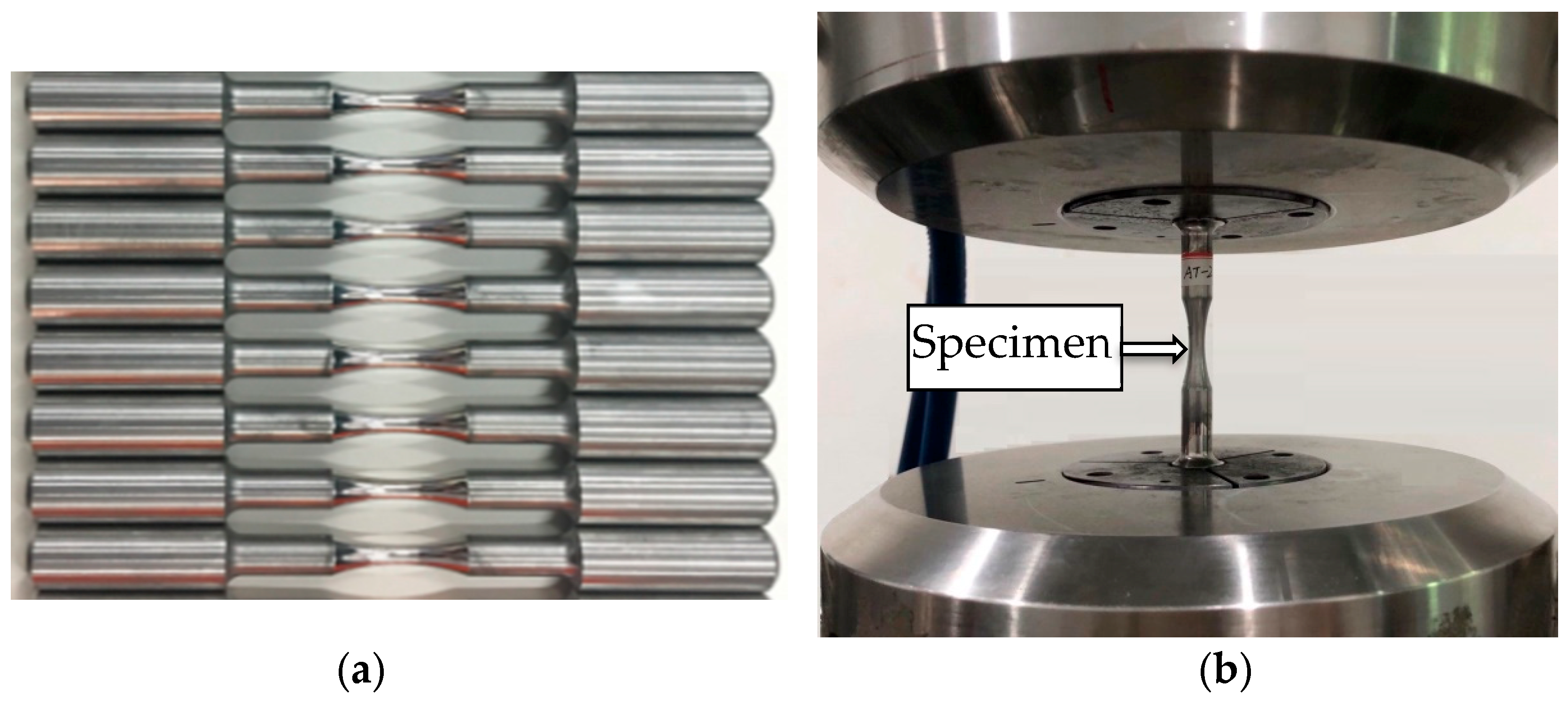
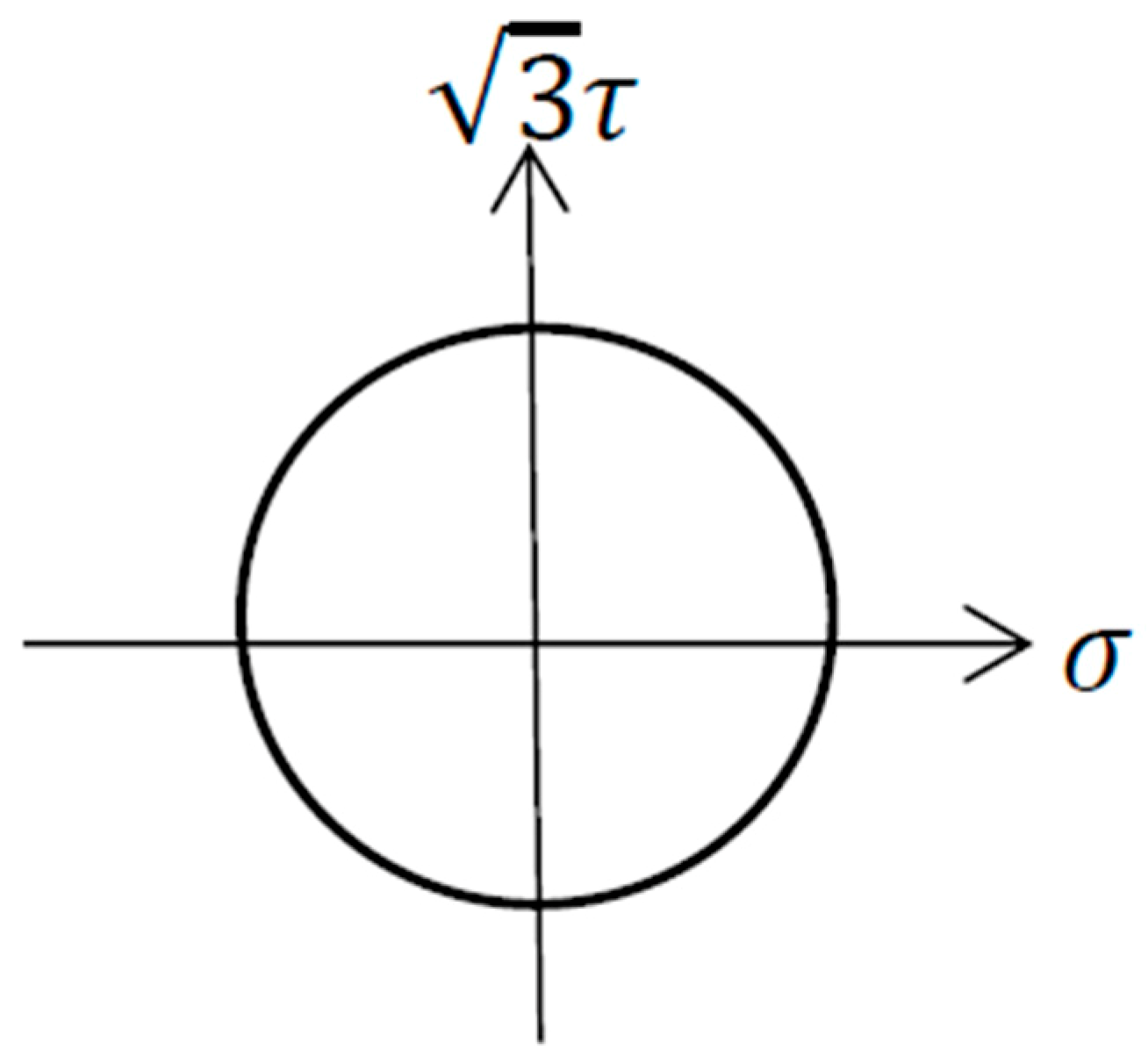
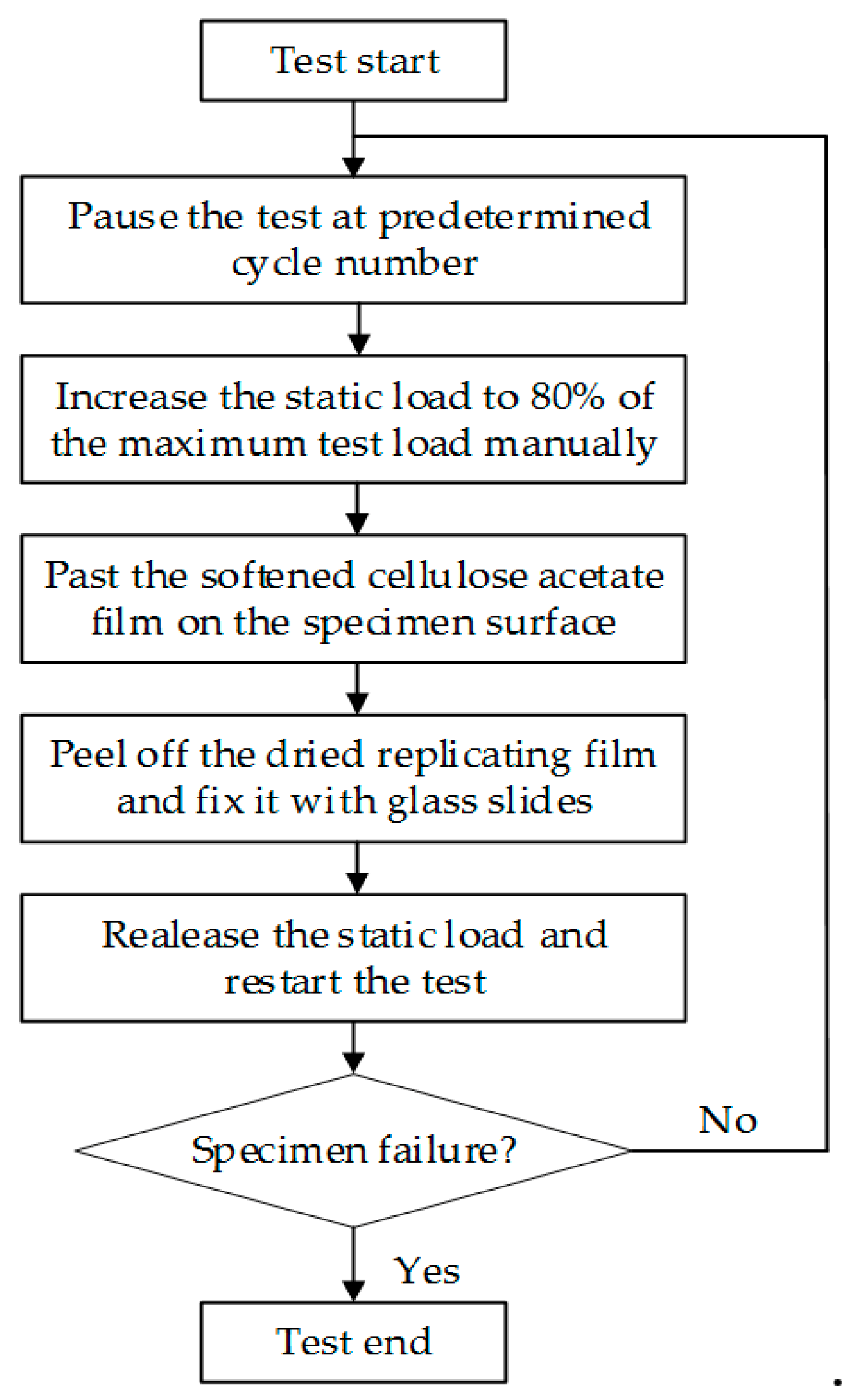
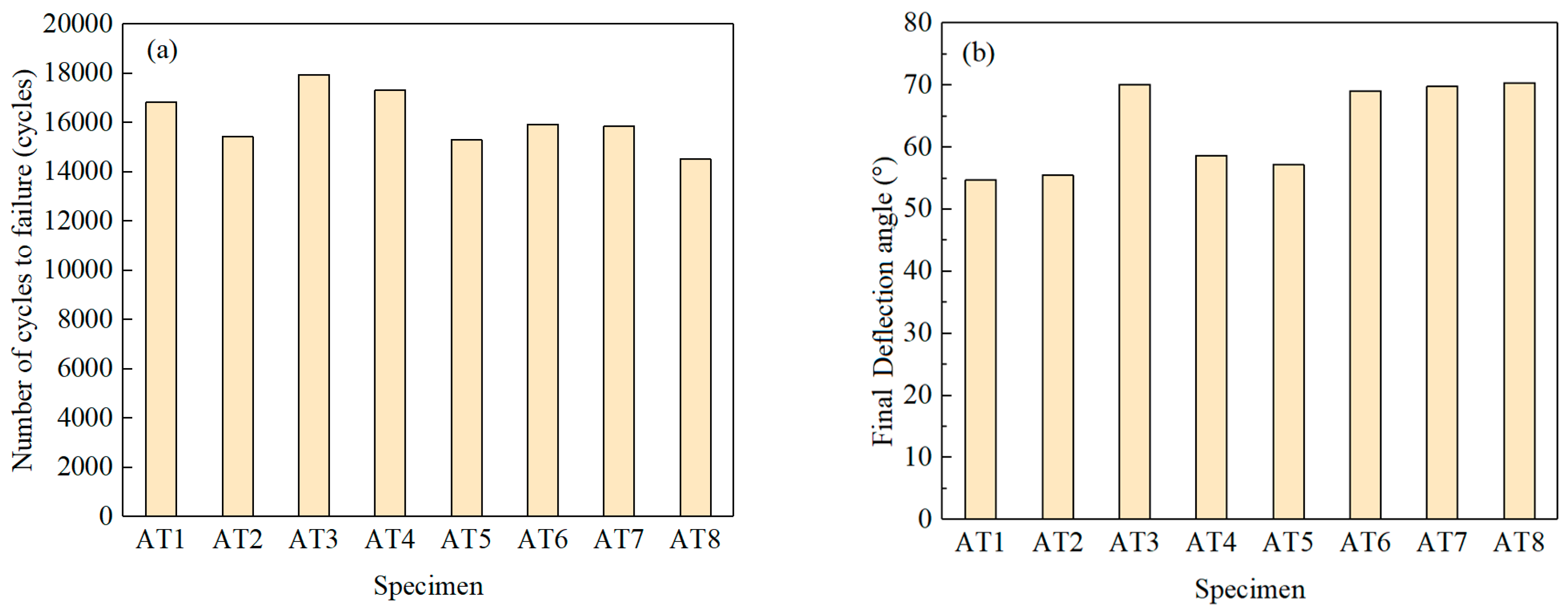
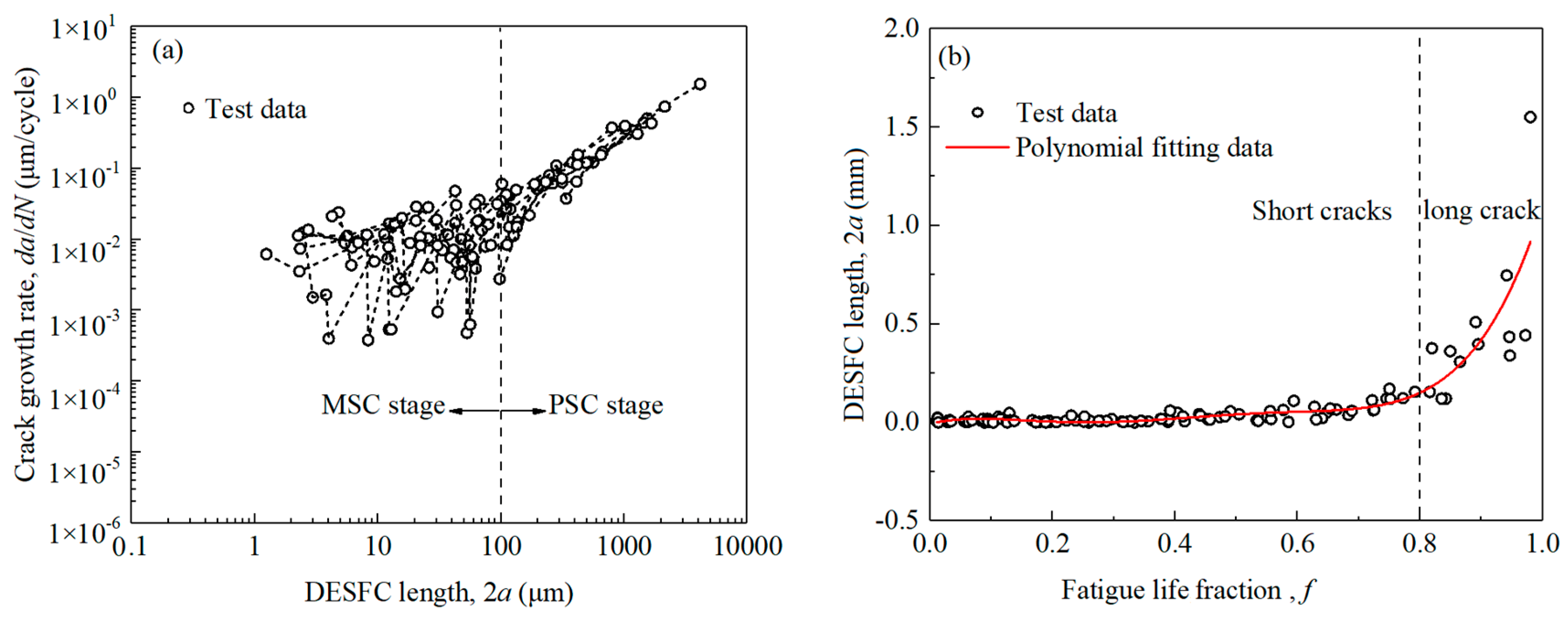


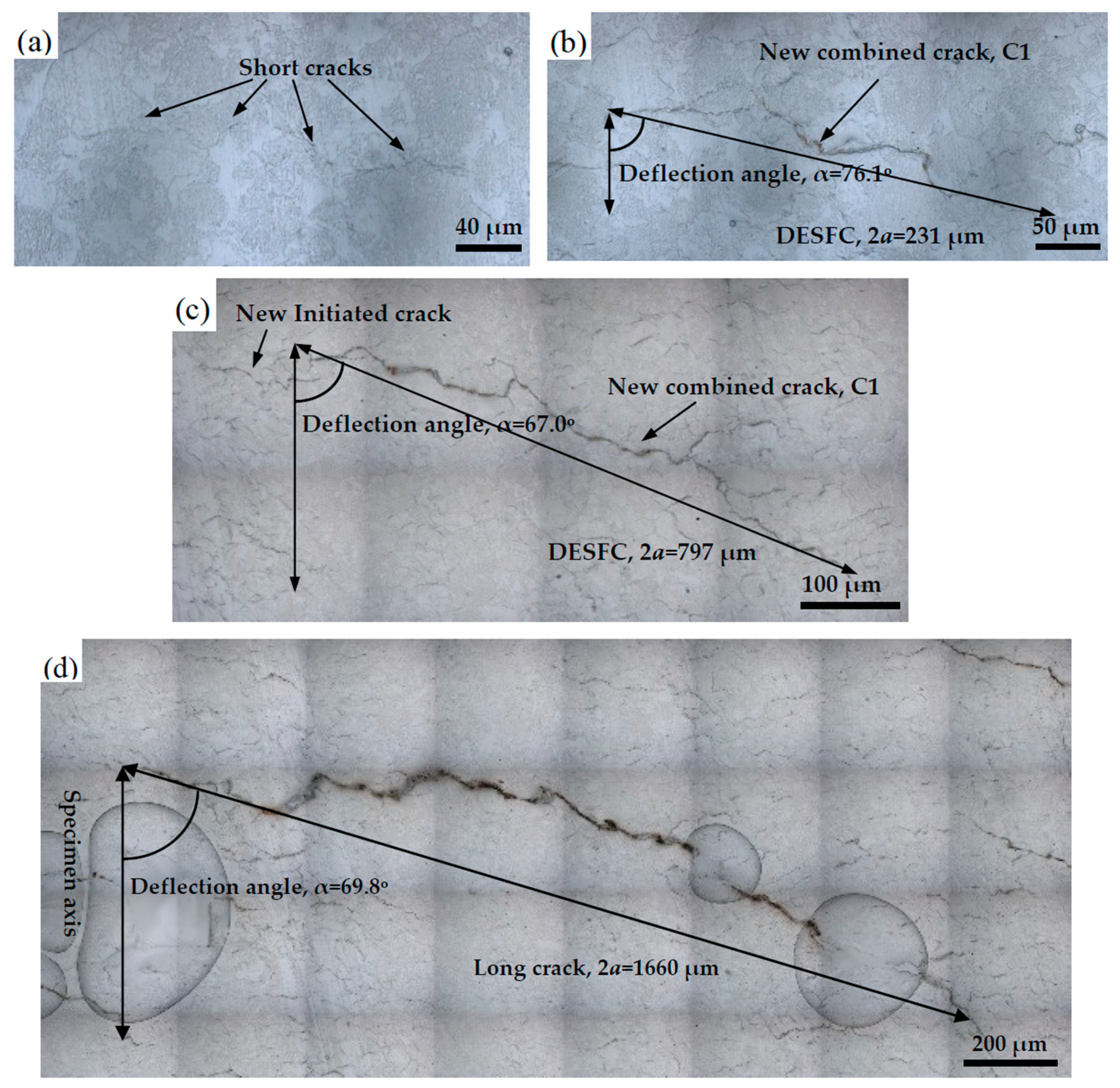

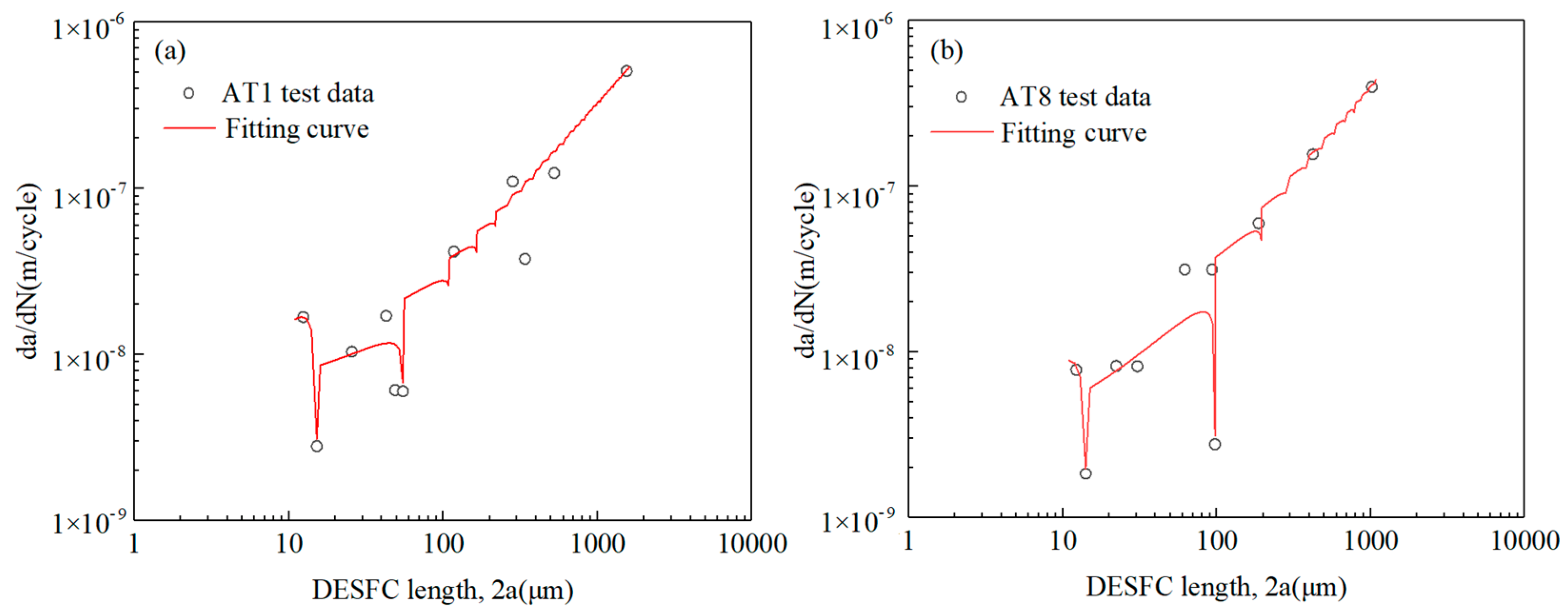
| Poisson Ratio (-) | Young’s Modulus (GPa) | Flow Stress (MPa) | Ultimate Tensile Stress (MPa) |
|---|---|---|---|
| 0.31 | 210 | 330 | 629 |
| Specimens | Pmax (N) | Tmax (N⋅m) | Phase Angle (o) | |||||
|---|---|---|---|---|---|---|---|---|
| AT1~AT8 | 9600 | 340 | −1 | 8.3 | 340 | −1 | 480 | 90 |
| Specimen | AT1 | AT8 |
|---|---|---|
| d1 (μm) | 15.20 | 14.09 |
| G01 (μm/cycle) | 2.80 × 10−3 | 1.84 × 10−3 |
| A1 | 2.38 | 1.94 |
| (MPa·μm) | 3.2 × 10−2 | 3.09 × 10-2 |
| m1 | 2.13 | 2.33 |
| α1 | 0.35 | 0.38 |
| d2 (μm) | 54.8 | 97.51 |
| G02 (μm/cycle) | 6 × 10−3 | 2.77 × 10−3 |
| A2 | 1.02 | 1.36 |
| (MPa·μm) | 3.18 × 10−3 | 2.83 × 10−3 |
| m2 | 1.05 | 1.06 |
| α2 | 0.33 | 0.27 |
© 2020 by the authors. Licensee MDPI, Basel, Switzerland. This article is an open access article distributed under the terms and conditions of the Creative Commons Attribution (CC BY) license (http://creativecommons.org/licenses/by/4.0/).
Share and Cite
Yang, B.; Liao, Z.; Xiao, S.; Yang, G.; Zhu, T.; Zhang, X. Study on Short Fatigue Crack Behaviour of LZ50 Steel Under Non-Proportional Loading. Materials 2020, 13, 294. https://doi.org/10.3390/ma13020294
Yang B, Liao Z, Xiao S, Yang G, Zhu T, Zhang X. Study on Short Fatigue Crack Behaviour of LZ50 Steel Under Non-Proportional Loading. Materials. 2020; 13(2):294. https://doi.org/10.3390/ma13020294
Chicago/Turabian StyleYang, Bing, Zhen Liao, Shoune Xiao, Guangwu Yang, Tao Zhu, and Xiangning Zhang. 2020. "Study on Short Fatigue Crack Behaviour of LZ50 Steel Under Non-Proportional Loading" Materials 13, no. 2: 294. https://doi.org/10.3390/ma13020294
APA StyleYang, B., Liao, Z., Xiao, S., Yang, G., Zhu, T., & Zhang, X. (2020). Study on Short Fatigue Crack Behaviour of LZ50 Steel Under Non-Proportional Loading. Materials, 13(2), 294. https://doi.org/10.3390/ma13020294






